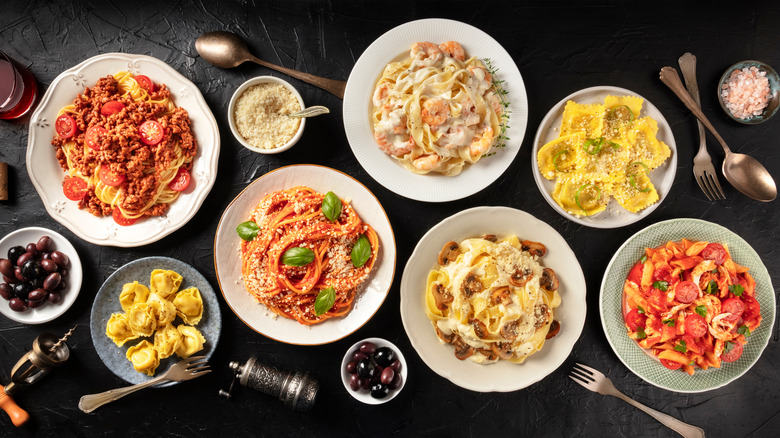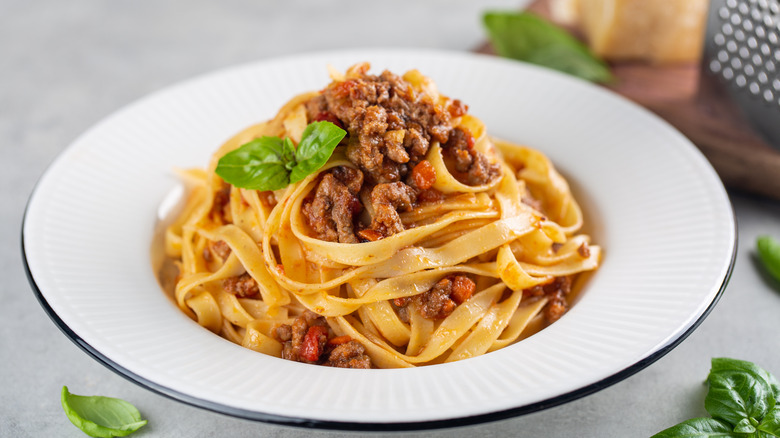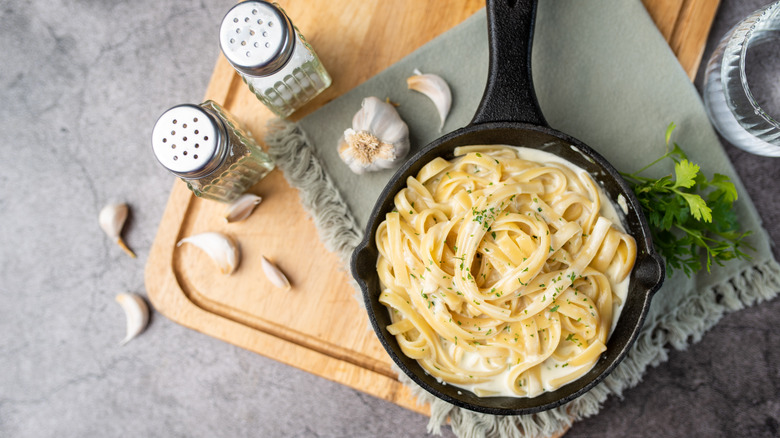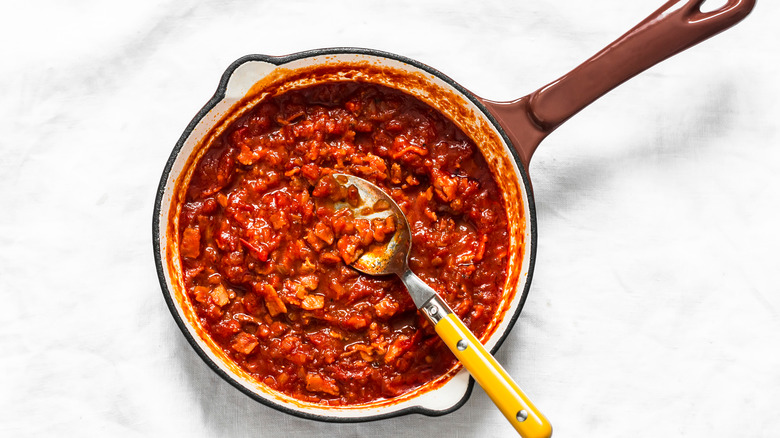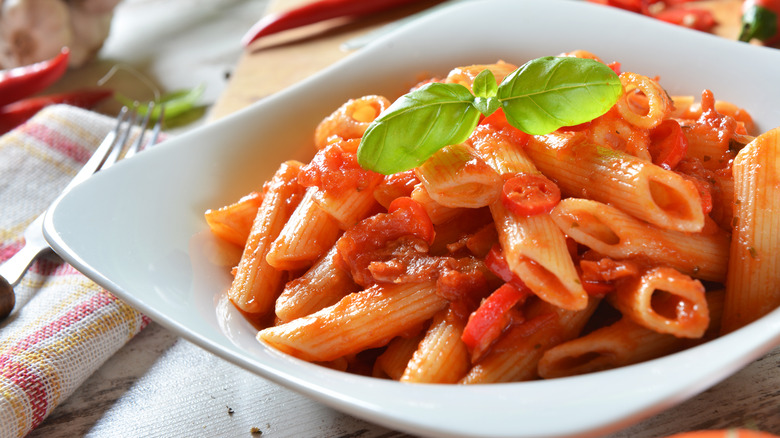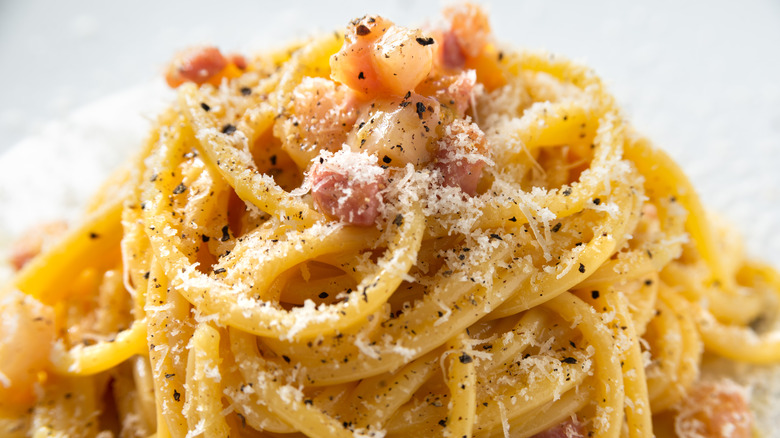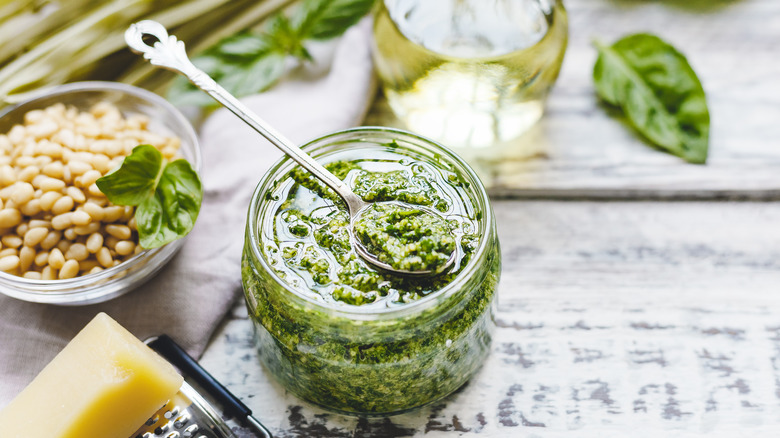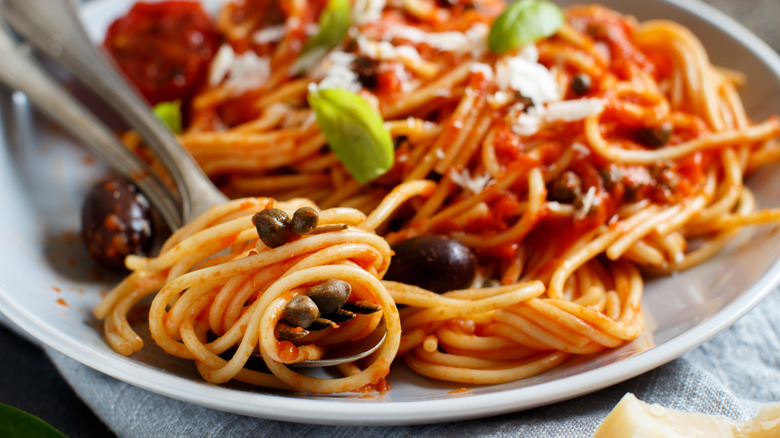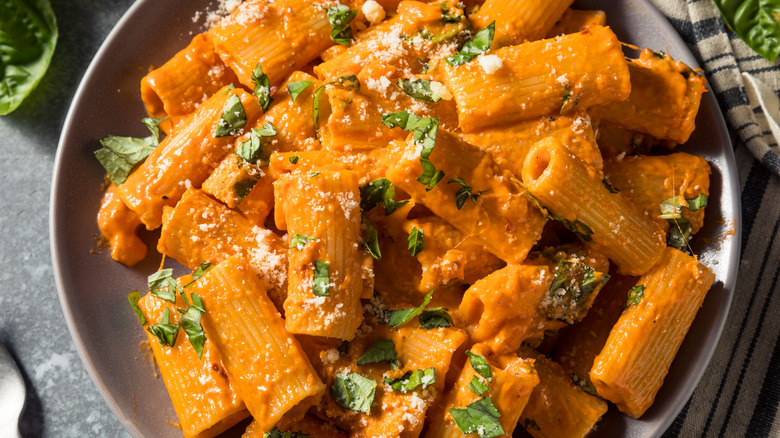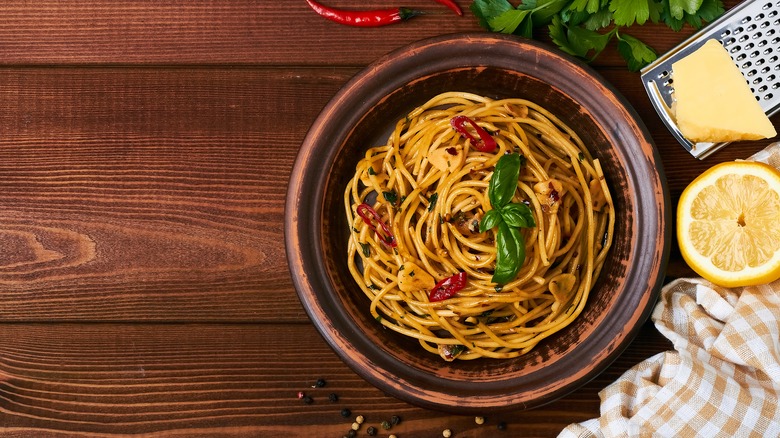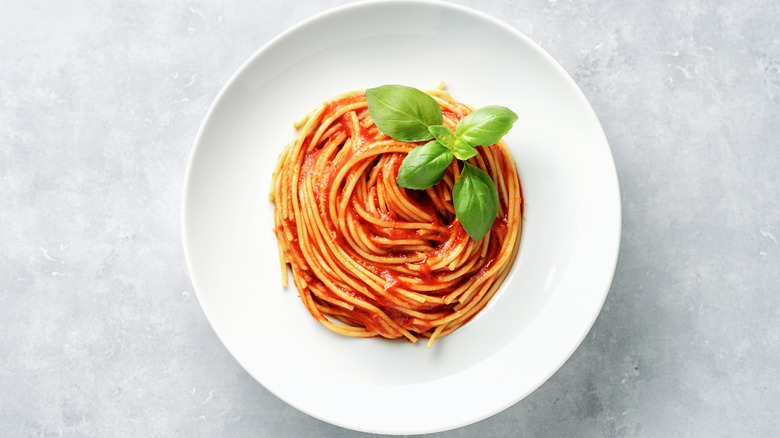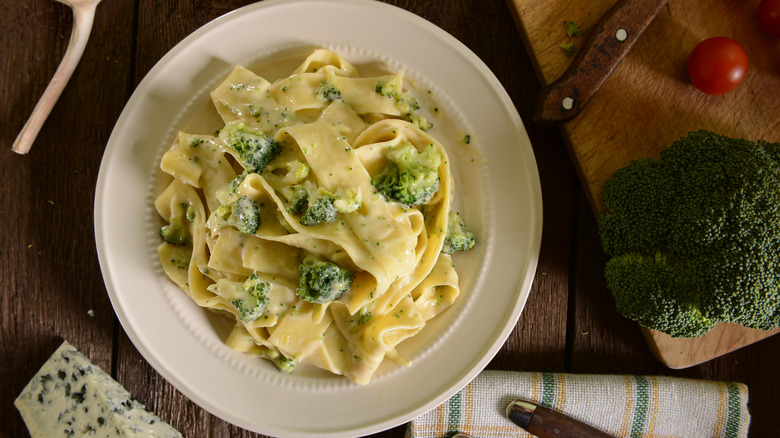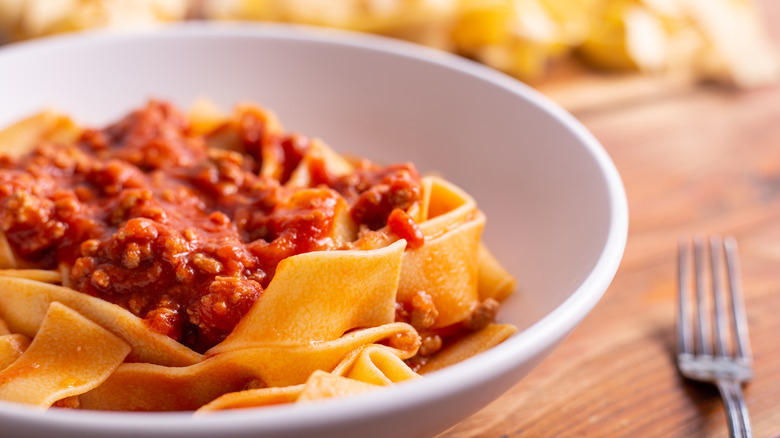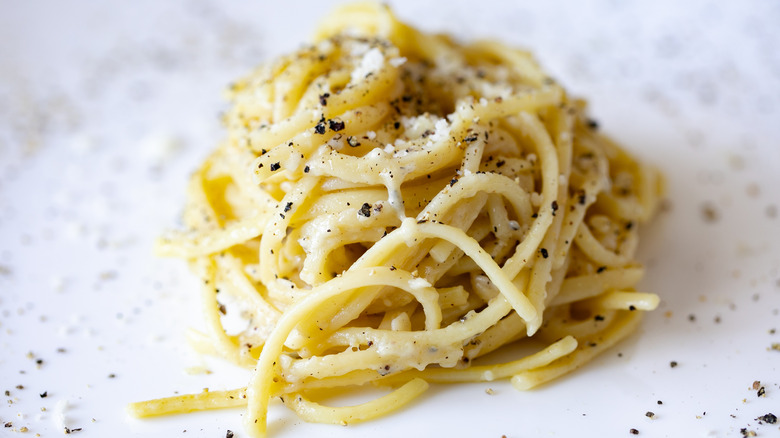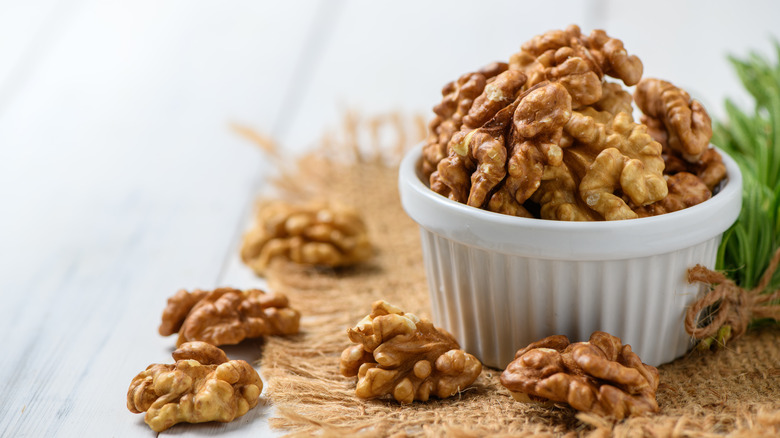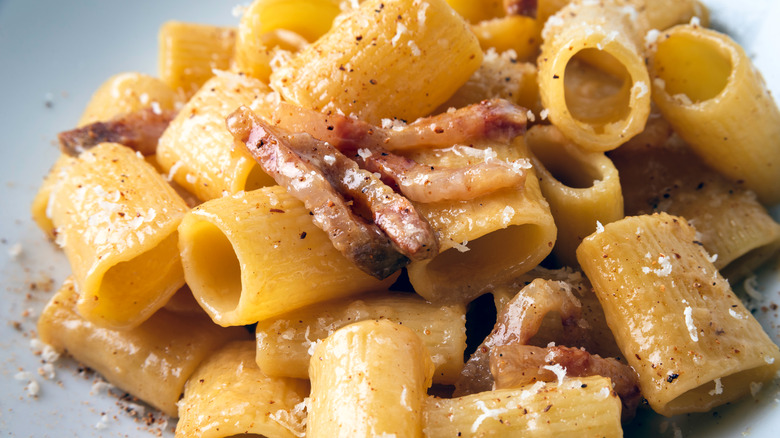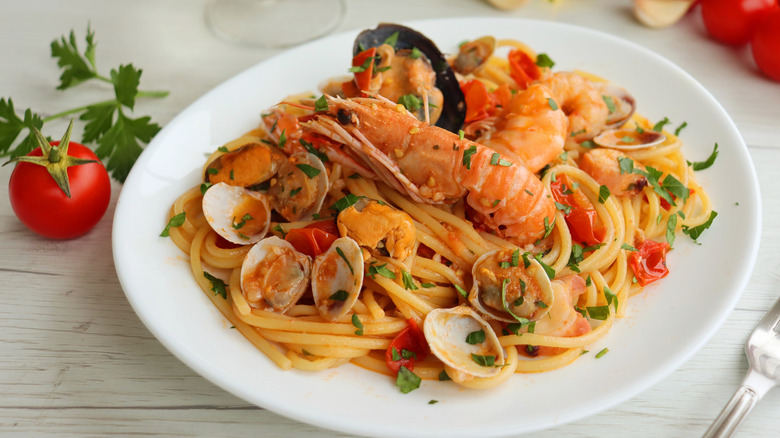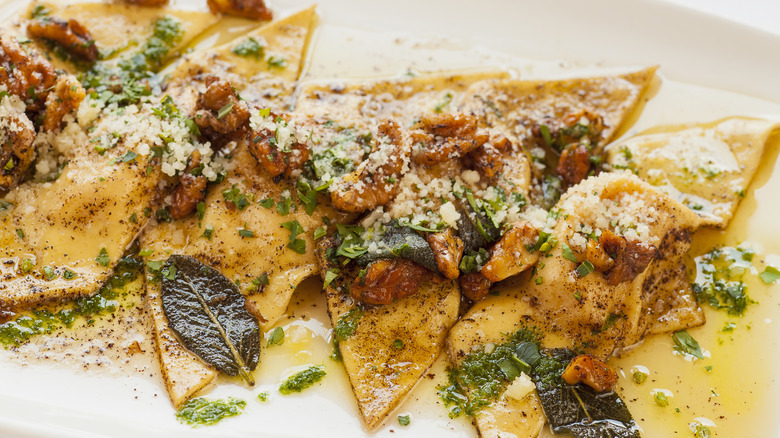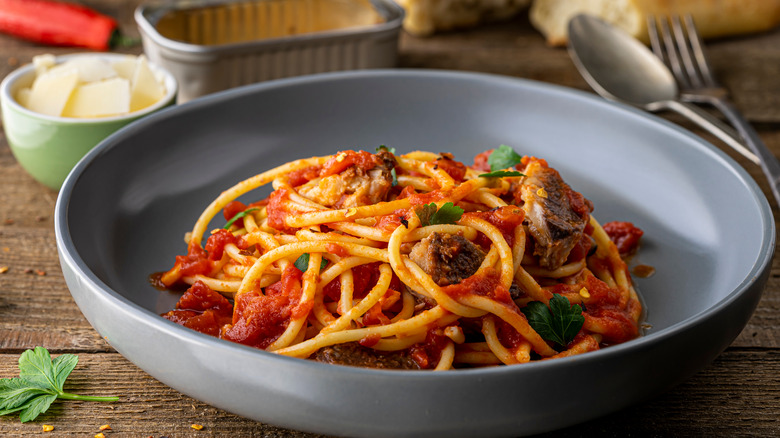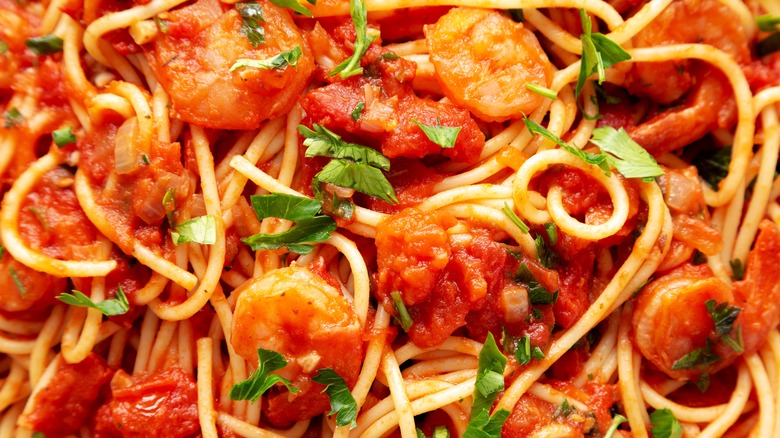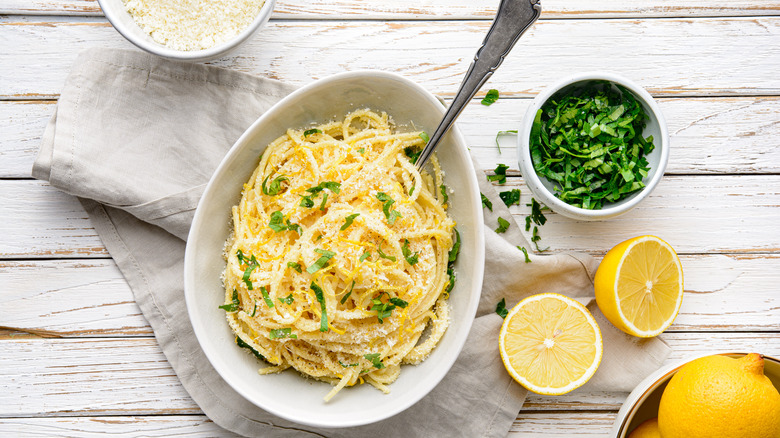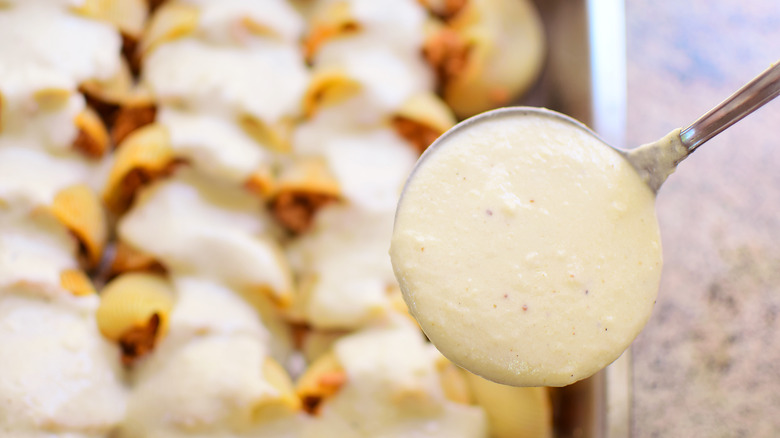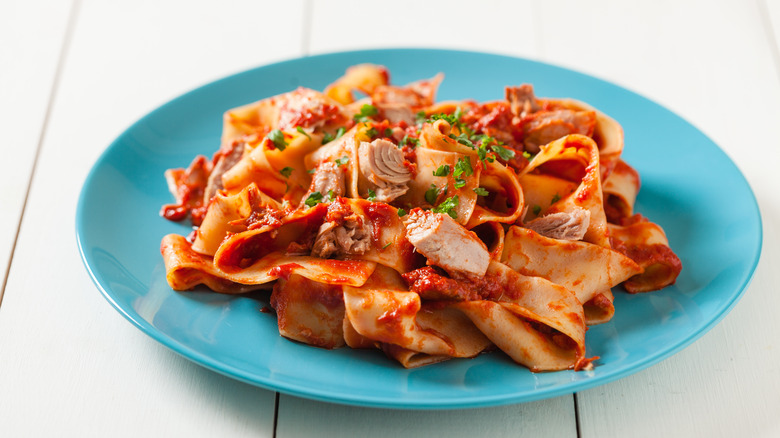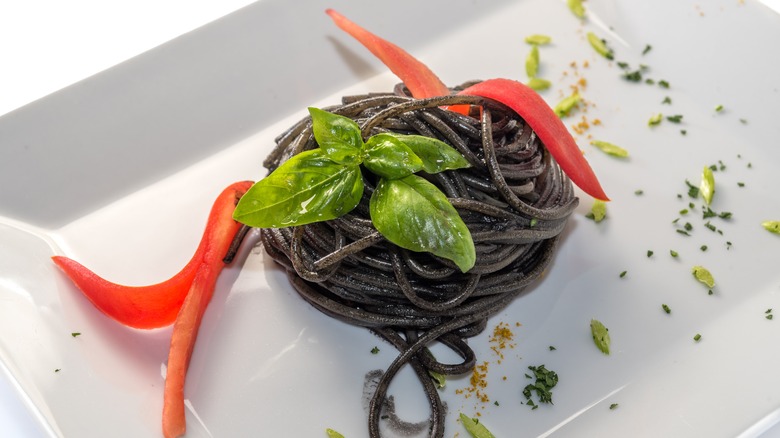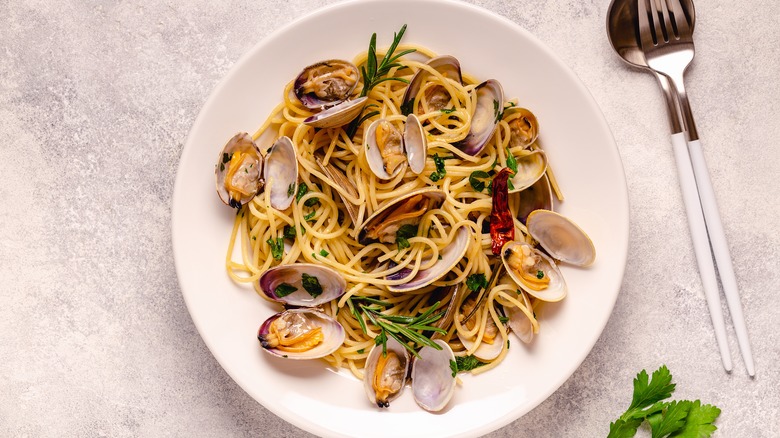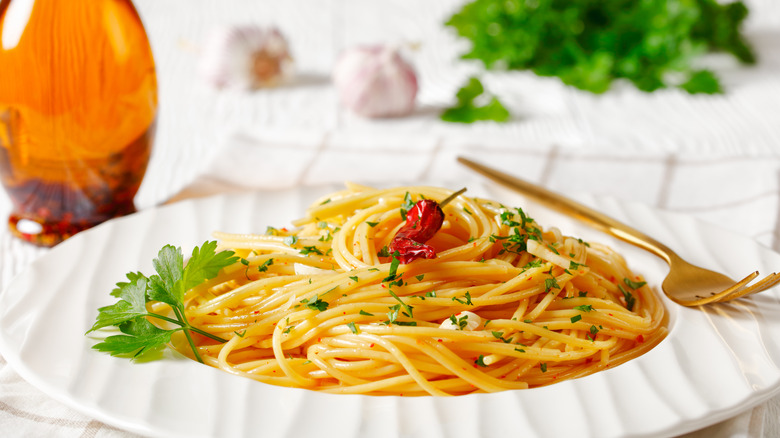26 Types Of Pasta Sauce Explained
It is assumed that over 600 types of pasta exist in the world (via Share the Pasta). Depending on the shape of each pasta, Italian cuisine is careful to pair it with the right type of sauce. Thin and delicate pasta requires equally light butter or oil-based sauces, whereas cream and cheese sauces are best left to sturdier strands (via Dellalo). Tube-shaped pasta is ideal for meaty or chunky tomato sauces that can nestle inside the hollow centers. Pairing your pasta shape with the right type of sauce can make all the difference between a dry plate of pasta and one that generously packs the sauce in each bite.
Different regions of Italy are famous for different kinds of pasta sauces. In northern Italy, cold temperatures, mountainous terrain, and a preference for gamey meats mean that the region is home to meaty sauces. In contrast, ingredients like tomatoes, eggplants, and olives grow in abundance thanks to the warm climate of southern Italy. Southern Italy also tends to use more pepper than the north, and the region's coastline makes seafood a popular ingredient.
Interestingly, some of the most common pasta dishes — like spaghetti and meatballs or fettuccine alfredo — were actually invented in America. An influx of Italian immigrants in the U.S. has given rise to an entire cuisine known as Italian-American (via More Time To Travel). As a result, there are a ton of pasta sauces today, each of which serves a saucy purpose of its own.
Bolognese
Bolognese sauce is famously served as spaghetti bolognese (or spag bol as the lingo goes). But it may surprise you that the saucy pasta is quite a controversial dish, not just outside of Italy but within the country too. A few years ago, Chef Antonio Carluccio had non-Italians in an uproar when he stated that spaghetti bolognese simply did not exist in Italy (via The Telegraph). Meanwhile, others claim that the closest thing to the dish you'll find in Italy is Ragù Alla Bolognese served over wide tagliatelle noodles (via The Local).
Ragù is any sauce that is made by simmering meat over low heat for a long period of time. While several types of ragús exist in Italy, Ragù Alla Bolognese hails from the city of Bologna and is easily the most famous. Others, however, insist that spaghetti bolognese, or spaghetti al ragù, is indeed an authentic Italian dish that has been around for at least five centuries (via The Guardian).
Interestingly, tomatoes are not central to traditional bolognese (via Martha Stewart). Instead, finely chopped pork, beef (sometimes veal), and pancetta are slow-cooked with vegetables, spices, and milk for three to five hours into a rich and hearty sauce. Traditionally, bolognese doesn't contain any herbs or garlic.
Alfredo
You'll be surprised to know that the original version of the alfredo sauce is said to have looked nothing like the cheesy and creamy mix that we know today. According to Forbes, the sauce was invented in 1914 by Rome-based restaurateur Alfredo Di Lelio. In an attempt to make a pasta dish that would please his wife, who had lost her appetite after giving birth, he made a dish called Fettuccine all'Alfredo with three ingredients that she could stomach — butter, Parmigiano Reggiano, and fettucine. Shockingly, the original version of alfredo sauce had no cream, flour, or herbs — it didn't even have garlic! All that gave the sauce its flavor was a rich triple cream butter and cheese that was cut from the core of a Parmigiano Reggiano wheel.
When alfredo sauce and Fettuccine all'Alfredo made their way to the U.S. — thanks to Hollywood stars Douglas Fairbanks Sr. and Mary Pickford, whose love for the dish gave it a press boost — American cooks were faced with a problem. According to Saveur, the cheese and butter in the states were far inferior in quality to the Italian ingredients of the original Di Lelio recipe. As a result, it's likely that Americans added cream to the sauce to mimic the creaminess of the original alfredo. To date, most restaurants in Italy will have two kinds of alfredo sauce on their menu — al burro (with butter) or alla crema (with cream) for the tourists. What both versions have in common though, is the use of fettuccine pasta.
Amatriciana
While alfredo and bolognese sauces have non-Italian influences on how they are prepared and served, amatriciana is one of the most famous traditional Italian pasta sauces that are often left untouched. According to The Guardian, shepherds from the Italian town of Amatrice would carry with them pecorino cheese, pork jowl (guanciale), pasta flour, and an iron pan when they traveled away from home. The sauce they made from these ingredients was called amatriciana, named after the town that it came from. While this version is best known as white amatriciana, the spicy red amatriciana famous today appeared around the 18th century when chili and tomatoes were introduced to the country from America.
According to Italy Magazine, Amatrice passed a resolution in 2015 officially recognizing both red and white versions of the sauce. While both versions are made with spaghetti, neither uses onions and garlic. The rules for making amatriciana sauce are so strict that when chef Carlo Cracco — whose Milanese restaurant earned two Michelin stars — admitted that he used garlic as the secret ingredient in his amatriciana, all of Amatrice was scandalized. In fact, The Guardian reports that the mayor of the town even released a statement hoping that the admission was a faux pas on the chef's behalf. Instead, officials of the town say that amatriciana should be made with only six ingredients: guanciale, pecorino cheese, San Marzano tomatoes, white wine, pepper, and chili. To alter the sauce not only messes with its flavor but also messes with the history of the town.
Arrabbiata
From Rome and the Lazio region, arrabbiata is a simple sauce made from equally simple ingredients: tomatoes, pecorino cheese, garlic, and oil (via Eat & Walk Italy). However, the most significant ingredient that goes into the making of arrabbiata sauce is chili pepper. In fact, MasterClass says that the word arrabbiata is Italian for angry, meaning spicy and arrabbiata go hand-in-hand.
While American versions of arrabbiata tend to leave out the meat, MasterClass says that Roman arrabbiata usually has pancetta. Whether or not you choose to add pancetta, the simplicity of arrabbiata sauce means that it's important to nail the few ingredients that go into its making. Choosing fresh tomatoes in season over canned ones, whole dried peperoncini rossi or hot red peppers over chili flakes, and pecorino romano over parmesan can make all the difference. Best eaten tossed in penne pasta, arrabbiata sauce will go down easier with a glass of red wine to alleviate its spicy heat.
Carbonara
A few years ago, Nigella Lawson got into hot water when she added cream and nutmeg to her carbonara (via The Sun). A little later, The New York Times faced the wrath of furious Italians when the site suggested adding tomatoes to a traditionally tomato-less carbonara for some tang (via The Guardian). The controversial sauce, though popular around the world, is a hotly disputed topic amongst traditionalists and those willing to experiment with ingredients.
Made with Pecorino Romano and Parmigiano Reggiano, eggs, pepper, and guanciale or pancetta, each ingredient in the making of carbonara is contentious (via Italy Magazine). The stage at which you choose to beat in the eggs, whether you add the yolk, and the pasta you choose for the sauce are all heavily scrutinized. Even the origin of carbonara is debatable. According to Taste, some believe that carbonara is named after carbonai — coal miners who are credited with inventing the sauce using ingredients that didn't require refrigeration. Others think that carbonara was made using the army rations of American soldiers stationed in Italy during World War II, which included powdered eggs.
There's no universal agreement on anything related to carbonara. If you're eating the sauce outside, be prepared for it to taste different depending on where in the world you are or even the restaurant you're at. However, if you're making it at home, go ahead and make it to your liking — cream or no cream, no one's judging.
Pesto
Pesto is one of the rare pasta sauces that doesn't call for tomatoes or meat, and it doesn't need to be cooked either. In fact, Paesana brand pasta sauces state that pesto should never come in contact with any heat that's not the residual warmth of freshly cooked pasta or meat. Also called pesto alla Genovese, pesto comes from Genoa, the capital of the Liguria region (via Italian Traditions). According to Saveur, pesto gets its name from pestare, the Italian verb for "to crush."
The traditional bright green-colored pesto consists of pine nuts, basil, hard Italian cheese, and garlic, all ground together in a coarse paste using extra virgin olive oil (via Eat & Walk Italy). As with most pasta sauces, however, plenty of pesto variations exist, including versions made with pistachios, walnuts, fruits, and vegetables. Pasaena says it's best to use pasta shapes with curves and ridges with pesto. The reason is that these shapes will help the oil-based pesto sauce cling onto them better, which is why fusilli, rotini, and farfalle are popular types of pasta to serve with pesto. You may even want your pesto to linger around in the refrigerator for a few days before you use it, as the sauce's flavor will only intensify over time.
Puttanesca
With an interesting name, puttanesca sauce has an equally interesting story attached to its origin. According to Thrillist, puttanesca roughly translates to "lady of the night," insinuating a sex worker. Some historians believe that the sauce originated somewhere around World War II when women turned toward sex work. Loose theories suggest that puttanesca sauce was easy enough to throw together between a change of clients. Others believe that the sauce gets its name from puttanata qualsiasi (Italian for "just make us whatever"), which led to a sauce that is made from a mishmash of leftover pantry ingredients (via Do Bianchi).
Regardless of its origin, there exist two versions of the puttanesca sauce (via Eat & Walk Italy). Naples' version of puttanesca calls for tomatoes, black Gaeta olives, garlic, capers, oregano, and olive oil which is then tossed into spaghetti, linguine, or vermicelli noodles. Rome uses the same recipe, except it adds salted anchovies and prefers penne and spaghetti. Slate says that the use of anchovies and olives with tomato gives puttanesca a sweet but pungent and umami flavor. The lack of anchovies in the Neapolitan version is also why puttanesca often goes by the name of aulive e cchjapparielle aka olives and capers in Neapolitan (via The Local).
Marinara
Often confused with a plain tomato sauce, Substitute Cooking says that marinara is less thick in texture and easier to cook than the former. Made with tomatoes, garlic, crushed red pepper, and basil, the name of the sauce is commonly believed to have originated from Italian sea merchants, giving the sauce its informal name, "mariner-style" sauce (via Paesana). Delighted Cooking also adds that marinara was preferred on ships, possibly because its lack of meat made it easier to store on long journeys before refrigeration.
Although marinara is delicious by itself, the sauce can also be used as a base for the more complicated tomato-based sauces (via Fork + Plate). According to Paesana, the classic marinara sauce uses San Marzano tomatoes that are low in acidity. While this makes marinara a simple sauce that is quick and easy to make, it also means that the sauce lacks the complex flavor profile of most other pasta sauces. However, the simplicity of marinara can work in your favor if you want a sauce that will allow the flavor of freshly prepared pasta to shine without overpowering it.
Vodka Sauce
As with most sauces, who exactly invented vodka sauce is a matter of great debate not just amongst different regions of Italy but amongst different countries, too. The U.S., it turns out, also lays claim to having invented the possibly Italian-American pasta sauce. According to Foodicles, two individuals claimed to have invented the boozy sauce in the 1980s. One of them was a Columbia University student by the name of James Doty, and the second was Chef Luigi Franzese of New York-based Orsini Restaurant, who is said to have used a splash of vodka to thin a tomato sauce.
A restaurant in Bologna also credits itself for coming up with the sauce along with a Roman chef who insists it was he who invented it at the behest of a vodka company wanting to popularise the spirit amongst wine-drinking Italians. What is generally believed, however, is that vodka sauce was famous in Italy long before it was in the U.S., and now that it is popular in America, the sauce is rarely ever found in Italy.
No matter its invention, vodka (and alcohol in general) works as a brilliant emulsifier in sauces, says Paesana. This is why the addition of the booze to caramelizing tomatoes creates a smooth pink-colored sauce that is immensely rich and creamy, which sits between a basic tomato sauce and a white Alfredo sauce.
Aglio e Olio
Simpled translated from Italian as "garlic and oil," aglio e olio is as simple as a pasta sauce gets. The Dickinson Press even compares the sauce to the grown-up version of plain buttered noodles. Sometimes, hot chili peppers get added to the mix, and the sauce is called aglio olio e peperoncino. According to The Pasta Project, along with puttanesca and scarpariello, aglio e olio is considered to be a part of the poor man's recipes (cucina povera) from the cuisine of Naples.
Because aglio e olio requires only a handful of ingredients, how and when you use them makes all the difference. Some prefer to coarsely chop peeled garlic into chunks, whereas others add entire garlic cloves to oil and pluck them out once the garlicky flavor is infused into it. Whatever you do with the garlic, make sure not to overcook and burn it. Peperoncini, if used, are best when added fresh and deseeded. Traditional aglio e olio recipes usually forgo cheese, but a fresh hard Italian cheese like Pecorino Romano or Parmigiano Reggiano can be a nice addition. As for the olive oil, the better its quality, the better your sauce will taste.
Traditionally, the sauce calls for long noodle-like pasta such as vermicelli, spaghetti, or linguine. It's also a good idea to save your pasta water for this sauce, as the starchy water can help the oil-based sauce thicken and soften the garlic pieces so that they blend with the pasta.
Scarpariello
Scarpariello sauce gets its name from scarpari, Italian for shoemakers (via Giallo Aferano). Thanks to its peculiar name, there are several legends behind the invention of the pasta sauce. According to certain theories, scarpariello was invented at a time when it was common for Italian shoemakers in the Quartieri Spagnoli district of Naples to be paid in groceries. Using whatever scraps of cheese they had, leftover tomato sauce, and a handful of basil leaves, the shoemaker's sauce was born.
The common factor amongst all theories is that scarpariello sauce is made from the meaty Neapolitan ragù that is leftover from the weekend before. To make the leftovers more filling, a generous amount of cheese is added to the sauce. Over the years, the recipe has evolved, creating variations like the addition of rich lard or scialatielli pasta and yellow tomatoes for a version popular in some parts of the Campania region. Whatever the version, one thing is ensured — scarpariello is always delicious.
Quattro Formaggi
While quattro formaggi is a name famously given to four-cheese pizzas, it also happens to be a popular pasta sauce. As the name suggests, quattro formaggi is made from four kinds of cheese. Unlike several other pasta sauces that come with a strict set of dos and don'ts — disregarding which is blasphemous — the four-cheese sauce surprisingly has no rules! As long as you're using four different varieties, The Wise Geek says that you could even mix soft and hard cheeses with different flavors and textures.
The choice of cheese is yours, but one you probably want to avoid is mozzarella. Though it's a staple of Italian cuisine (and would almost certainly be found on a four-cheese pizza), it doesn't blend well into pasta sauces. Luckily, there are plenty of other options, including provolone, fontina, ricotta, gorgonzola, and of course a dusting of Parmigiano Reggiano to finish off your quattro formaggi.
Sunday Sauce
A quintessential part of Italian-American cuisine, Munchery says that Sunday Sauce — or Sunday Gravy in some places — originated from the influx of Italian immigrants into the U.S. between 1870 and 1920. In America, these Italian immigrants could more easily afford beef than they could in Italy, creating a tradition of the meaty Sunday Sauce.
Sunday Sauce is traditionally prepared on — you guessed it — a Sunday. Allowing browned meat to simmer in a tomato sauce for long hours gives the meat time to infuse into a thick sauce, giving families time to enjoy each other's company (via The Saturday Evening Post). In the past, the sauce was allowed to slowly cook while families went to church on Sunday mornings.
Sunday Sauce regularly begins with some kind of meat base, be it beef, pork, veal, or a combination of all three. Browning the meat first before adding other ingredients helps the sauce start with a base that is already rich. The meat should then be cooked with other ingredients for several hours until tender, a surefire sign of a perfectly cooked Sunday Sauce. Meatballs and sausage are common additions and usually left to simmer in the sauce after being baked or fried off.
Cacio e Pepe
Both the name of the dish and the name of the sauce itself, cacio e pepe is made using just three ingredients: cacio (cheese, specifically from sheep's milk), pepe (black pepper), and pasta (via BBC Travel). Popular theories claim that it was Italian shepherds who invented the cacio e pepe that we know today. Traveling for several months of the year in the Apennine Mountains, they carried with them dried pasta, black pepper, and cheese — three ingredients that were easy to transport, easy to store, and produced a saucy dish that was warming on cold nights. While they carried the pasta with them — usually tonnarelli — renowned chef Lidia Bastianich told Greatist that the cheese was made fresh from sheep's milk and was usually Pecorino.
As the sauce made its way to the U.S., ingredients like cream, butter, and olive oil often got added to the sauce. Nevertheless, all a traditional cacio e pepe needs are good quality cheese and a generous sprinkle of black pepper. The Guardian says that while tonnarelli or a square cut of spaghetti is preferred in Roman cacio e pepe, pici is another popular pasta that goes with the sauce. Some even prefer paccheri or rigatoni made from wholemeal flour, which is thought to go well with the salty flavor of the sheep's milk cheese.
Salsa di noci
Along with bright green pesto, Italy's northwest region of Liguria is also famous for its salsa di noci, a variant of pesto known as trofie con salsa di noci alla Genovese or walnut sauce (via The Pasta Project). In fact, some even believe that salsa di noci predates pesto alla Genovese.
Salsa di noci is similar to pesto in that it is a pasta sauce made using a mortar and pestle and requires no heating or cooking. The ingredients to make salsa di noci, however, are entirely different. Walnuts, parmesan, garlic, and olive oil aside, the sauce also calls for milk and white bread (via Inside the Rustic Kitchen). The bread is added to make the sauce thicker, and a mixture of milk and olive oil is used to make it creamier. It's also common for the sauce to be made with fresh walnuts rather than dried ones. Some even make their salsa di noci by boiling walnuts with their shells intact for a few minutes first, as this step is supposed to make the nut less bitter and sweeter.
According to The Pasta Project, salsa di noci is traditionally tossed in a type of Ligurian pasta known as pansotti, a ravioli stuffed with wild herbs and cheese. Although pansotti is the traditional preference, the walnut sauce goes just as well with any short and fresh pasta — think gnocchi, corzetti, or trofie.
Gricia
Made with only three ingredients, gricia is a peculiar pasta sauce in that it requires no tomatoes, oil, or eggs. Instead, the Roman sauce is made with Pecorino Romano, black pepper, and guanciale (via Italy Magazine). Some credit the town of Amatrice and its people with inventing gricia who, after moving to Rome, added tomatoes to the mix and gave the world the hot amatriciana. The Pasta Project even adds that gricia is often referred to as the white amatriciana.
Others say that the sauce comes from the town of Griciano situated close to Amatrice. Regardless of the theory you believe, gricia along with carbonara, cacio e pepe, and amatriciana, makes an important part of Rome's and Lazio's cuisine. It is even believed that gricia is the oldest of the four Lazio sauces, the base from which the other three sauces are made.
Because of its simplicity, it is important that you use guanciale and not pancetta if you're making the sauce at home. Additionally, while you could swap the pecorino for parmesan, the sauce will lack the sharp saltiness that is needed to balance the intensity of the guanciale. Some also tend to add red chili peppers, onions, and garlic to the sauce, but if you want it to be as close to the original Italian sauce as possible, it might be better to stick to just the three main ingredients. Once done, the sauce can be tossed with spaghetti or rigatoni and served.
Frutti di mare
A briny seafood sauce is the epitome of decadence, and frutti di mare is a dish made for a king. Frutti di mare translates to "fruit of the sea" in Italian, and this popular dish lives up to its name with a combination of seafood in a tangy tomato sauce. Like most Italian recipes, frutti di mare has many versions. The classic recipe includes clams, mussels, shrimp, and scallops. But depending on the chef and the region, frutti di mare can also include squid, anchovies, sardines, and other local varieties.
The best seafood combination for this classic sauce is whatever is fresh that day. Italy is surrounded by water and has an abundance of fresh seafood readily available, so it's no surprise the dish changes depending on the local catch of the day.
Traditionally, frutti di mare was served on Christmas Eve, but luckily it's available year-round, so you don't have to wait for the holidays to try it. Top a bed of spaghetti or angel hair pasta with frutti di mare for an elegant dish that is sure to impress.
Brown butter and sage
Sometimes a simple sauce is all you need, and that is the case with brown butter and sage sauce. With only three ingredients, you can easily bring this sauce together for an unforgettable meal. Brown butter and sage sauce include the namesake ingredients with a little garlic, and voila — it transforms these basic ingredients into a sauce that is anything but basic. This sauce works well with a complex pasta like gnocchi or butternut squash ravioli. Adding a fourth ingredient like walnuts adds some texture and contrasts the creamy butter and rich ravioli.
Making a sauce like this requires the best ingredients; fresh sage and rich butter are the key. Fresh sage has a deep earthy aroma and is commonly used to balance out a creamy, buttery sauce. According to SPICEography, fresh sage is excellent with starches like potatoes and pasta, while dried sage is ideal for roasted meats, like classic Thanksgiving turkey. When whipping up a butter sauce, timing is important, because brown butter can quickly turn to burnt black butter if you aren't paying attention. So keep the heat on low and stir frequently for a successful brown butter sauce.
Sicilian sardine sauce
Sardines are a staple in Sicilian cooking, and you can find them in a variety of classic Sicilian dishes. These versatile little fish can be fried, grilled, marinated, stuffed, and, of course, made into a sauce. Classic sardine sauce is made with sardines, anchovies, fennel, raisins, pine nuts, and saffron — all ingredients local to Sicily.
The dish has a long history; according to The New York Times, the Arab general who conquered Sicily wanted to feed his soldiers with the local foods available. He added touches from the Arab world — saffron and pine nuts, specifically — and the dish was born. The ingredient list may seem odd, but the briny oily fish balance the sweet raisins and fennel, while the floral, earthy saffron adds depth, and the pine nuts give the dish texture. Sicilian sardine sauce is usually served with bucatini, which is a type of pasta that looks like a thicker spaghetti noodle that is hollowed out like a straw. But if that doesn't work for you, a simple spaghetti or fettuccine is a great choice too.
If you want to recreate this dish but can't find fresh sardines, tinned sardines are fine to use. And you really should get more sardines into your diet, as they are a rich source of omega-3 fatty acids and healthy protein (via Healthline).
Fra diavolo
Fra diavolo translates to "brother devil" and is a spicy red sauce usually paired with seafood. The sauce's origins are debatable, with some claiming that it is traditional Italian sauce and others claiming it is an Italian-American invention of the 1930s (via The New York Times). The truth probably lies somewhere in the middle. This spicy sauce reflects southern Italian cooking, where the cuisine has been heavily influenced by the surrounding region and spicy sauces are common. Likewise, the fact that the sauce is primarily associated with shrimp, lobster, and other seafood is typical of the cuisine in southern Italy. It would be unusual to pair fra diavolo with other proteins like beef and pork.
Fra diavolo's murky origin story shouldn't detract from the unique qualities of the dish. It's a simple red sauce with garlic, parsley, and red pepper flakes. The heat is adjustable, so depending on the chef, it can range from mildly spicy to super spicy.
Lemon sauce
When you think of pasta sauces, you probably think of thick creamy Alfredo or rich red sauce, but pasta sauce doesn't have to be heavy. Lemon sauce pasta (or "pasta al limone") is an example of a light pasta sauce that won't weigh you down.
Lemons are a staple ingredient in cooking across the world, and for good reason. With a little squeeze, you get a burst of bright citrus flavor, so it's no surprise lemons have their own sauce. They aren't just the garnish or the spot of acid; instead, they get to be the key player. Lemon sauce is made with lemon juice, lemon zest, garlic, salt, and pepper whisked together and poured over long pasta like angel hair or spaghetti. Like most pasta sauces, it benefits from a generous sprinkle of Parmigiano Reggiano to really bring it together. Many restaurants will pair it with a protein like shrimp or chicken to make it a hearty meal.
Béchamel
Béchamel sauce is a white sauce made with milk, flour, and butter. According to Science of Cooking, the sauce was first included in a French cookbook in 1651. Although this first version was made with veal stock, today's béchamel leaves out the stock.
Béchamel is now considered one of the five mother sauces of French cooking. The other four are velouté, espagnole, hollandaise, and tomato. The sauces were developed by French chef Auguste Escoffierare, and are considered the base of French cooking where many quintessential French dishes start (via Healthline).
While béchamel sauce only has three ingredients, it takes some skill and patience to get it right — after all, you don't want a consistency that's too thick or thin. But it is worth the effort to perfect because it is perfect in many dishes. You can use béchamel with proteins like chicken and seafood, pair it with vegetables, or use it to make a creamy casserole. While it is a French sauce, Italian cuisine has adopted it. It's great for binding layers of cheese in baked pasta dishes like ziti or lasagna.
Tomato tonna
Tonna means tuna in Italian, and this sauce combines tuna with tomatoes for a quick, easy pasta sauce. Unlike other pasta sauces, this recipe does not have any hard rules about ingredients. As long as it has tomatoes and tuna, it can safely be called tomato tonna sauce. It is fine to add a few other ingredients; some chefs add parsley or basil, and some add capers and olives for a tangy twist. While you can use fresh tuna for this recipe, canned tuna is perfectly fine too. It's such a simple sauce to put together with pantry staples you might want to add it to your weekly menu rotation.
Canned tuna is often overlooked in the culinary community, but it shouldn't be because it's an inexpensive way to get more protein and the all-important omega-3s in your diet. Besides pasta sauce, there are many other ways to use canned tuna, so stock up on this staple.
Nero di seppia
Squid ink, or nerro di seppia, is a unique pasta sauce that is made with umami-rich squid or cuttlefish ink. Squid ink comes from cephalopods and is a black ink that is part of their protective system. When in danger, they squirt the black ink to cloud the water. According to The Guardian, squid ink has been used in the past for medicinal purposes to boost the immune system and as an anti-microbial. It was commonly used in the arts throughout the 1800s (via Healthline). While it boasts several health benefits, squid ink is used sparingly. A little goes a long way, so it's doubtful you could eat enough to actually see any health benefits. Nowadays, it is used as a flavor enhancer and a food dye. It's difficult to know when this pasta dish was created, as you can find squid ink throughout the Mediterranean, and it is also popular in Japanese cuisine.
Nero di seppia is well-known from Sicily to Venice, where local fishermen would use every part of the squid or cuttlefish, even the ink. If you are trying nero di seppia for the first time, don't be surprised if your teeth and tongue turn black. It might not be an ideal meal for a first date. But its unique color and briny, umami flavor will leave a definite first impression.
White clam sauce
Pasta in white clam sauce is a popular Italian dish. It is traditionally made with Mediterranean clams and extra virgin olive oil tossed with linguine or spaghetti. While the classic recipe for this clam sauce is strictly white, some versions add fresh cherry tomatoes, and others add tomato sauce, much to the chagrin of some pasta sauce purists (via Italy Magazine).
This elegant dish is easier to make than you might think; the key is to use fresh clams. If you are far from the Mediterranean, you can sub Mediterranean clams for more readily available little neck clams for a perfect white clam sauce. However, don't expect any cheese on it like you would with a famous Connecticut white clam pizza. White clam sauce is an Italian invention and does not have cheese, following the unwritten rule in Italian cuisine to never combine cheese and seafood. Connecticut white clam pizza, meanwhile, is a local invention and combines Romano cheese, clams, and olive oil. Delicious, but decidedly different.
Colatura di alici
Colatura di alici is an anchovy sauce made in Cetara, Italy. The name translates directly to anchovy drippings, which is exactly what the sauce is. According to Culinary Historians from New York, the anchovies are caught on the Amalfi coast throughout the spring and summer seasons, then filleted, salted, and stored to ferment with a weight on top to push out the juices. The juices that seep out are the colatura di alici. The entire process takes months and reaches the proper fermentation level close to the Christmas season, making it a seasonal delicacy eaten during the holidays (via Amalfi Coast). Similar to flavored olive oil, colatura di alici is drizzled on pasta, focaccia, roasted vegetables, or any other dish that would benefit from the rich umami taste.
Much like prosciutto, Parmigiano Reggiano, and balsamic vinegar, colatura di alici has DOP status, meaning that it must be processed and packaged in the region where it originated. Keep that in mind when looking to purchase a bottle of this amber-colored fermented fish sauce.
